|
| |
Back to private
aircraft
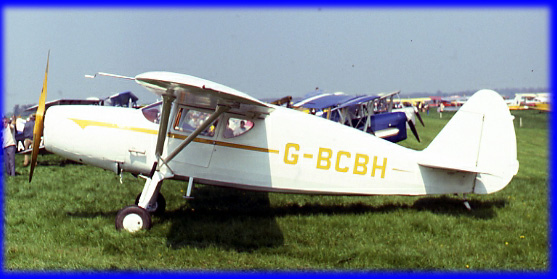 |
The Fairchild 24 Argus (also known as the
Forwarder) was a four seat light communications aircraft, which
first flew in 1933. Most had a 165hp Warner Scarab radial engine,
though some later models (the 24R Argus III) had a 175hp Ranger
inline. With a gross weight of 2,560lb, top speed of 130mph and 640
mile range, it was a useful, rugged performer for its day. Length is
23 feet 9 inches and wing span 36 feet 4 inches. Over 1,000 were
built, including several for the US Army Air Force (UC-61 and a few
as C-68) and US Navy (J2K), as well as several for the Royal Air
Force. This 24R was at Badminton in
April 1988. |
 |
The design for the Globe Swift was reputedly
inspired by Al Mooney's Culver Cadet. A racy two seater with
retractable undercarriage, it was intially (under) powered by an
85hp Continental engine, though this was quickly upgraded to 125hp.
The first aircraft flew in 1940, though the second world war delayed
production until 1945. It is 20 feet 10 inches long, with a wing
span of 29 feet 4 inches. It cruises at 125mph for a range of up to
1,000 miles. Gross weight is 1,975lb. 410 of the 85hp version were
made, plus 1,090 of the higher powered version. Many were built by
Temco in Texas.
This one was at Cranfield in July 1996. |
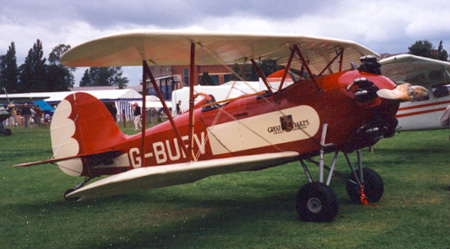 |
The Great Lakes 2T-1A is a two seat biplane
of robust construction, first flow in 1929. It is powered by a
Kinner R-55 five cylinder radial engine. 250 were built in the 1920s
and 30s; but the design was then revived in the 1970s, now powered
by a 180hp Lycoming AEIO360. It cruises at 115mph for a range of 375
miles. A compact machine, it is 21 feet 2 inches long with a wing
span of 26 feet 8 inches. Gross weight is 1,750lb. They are highly
sought after, and a rare sight in Europe.
This one was at Cranfield, July 1998 |
 |
The Grumman AA5 was a scaled-up four seat
development of Jim Bede's American Aviation AA1. Originally powered
by a 150hp Lycoming O-320 engine and named the Traveller, later
versions included the AA5A Cheetah and the 180hp AA5B Tiger. It
frist flew in August 1970. It cruises at 120mph, with top speed of
140mph and range of 475 miles (the Tiger manages 600). Gross weight
is 2,200lb (2,400 for the Tiger). Length is 22 feet and wing span 31
feet 6 inches. Over 3,200 have been built; the aircraft is still
available from Tiger Aircraft, who market it as the AG-5B.
This one was at Toussus-le-Noble in June 1979. |
 |
The Grumman Ag-Cat is a specialised
agricultural aircraft which first flew in May 1957. Initially
powered by a 220hp Continental radial engine, later versions had
engines up to a 450hp Pratt & Whitney R-985 nine cylinder radial. It
is a big aircraft, with a wing span of 35 feet 11 inches and gross
weight of 4,500lb, though it is only 23 feet 4 inches long. The
payload, including the single pilot, is 1,810lb, most of which are
the chemicals for spraying. 2,640 were built.
This one was at Toussus-le-Noble in June 1979. |
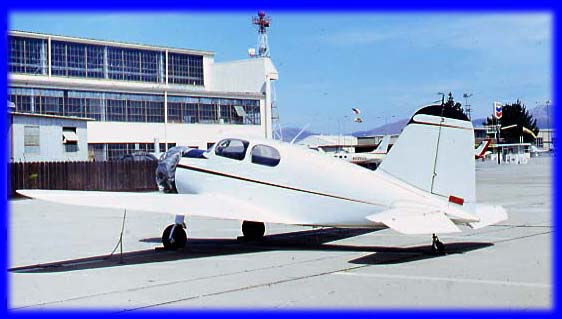 |
The Harlow PJC-2 was a two seater designed by
John Harlow while he was a teacher at Pasadena Junior College. It is
powered by a 165hp Warner Scarab radial, giving it a top speed of
160mph and cruising speed of 140mph, range of 490 miles, and gross
weight of 2,300lb. It proved sufficiently good to put into
production; 11 were built in 1939 and 1940 before the war caused
production to cease. Length is 23 feet 4 inches and wing span 35
feet 10 inches. Four of them were impressed into service by the US
Army Air Force, designated C-80. This
one was at Salinas in September 1981. |
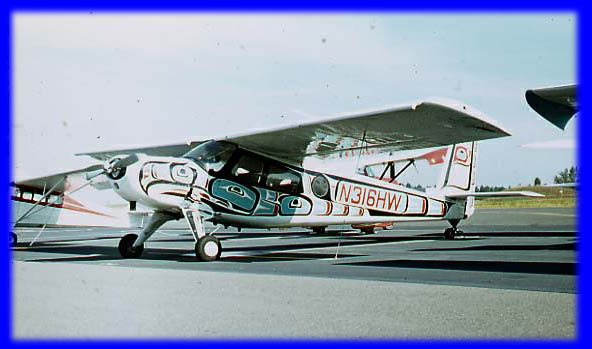 |
The Helio Courier is a rugged utility
aircraft which first flew in 1952. Its speciality is hauling medium
loads into and out of remote and awkward airstrips. For this, it is
powered by a 295hp Lycoming GO-480 engine. This enables it to gross
3,400lb, of which over 1,300 is payload. It will seat six (the
oldest versions seat four) and cruises at 160mph; range is 630
miles. Over 500 were built including many for the US Army, with whom
it was designated U-10. It is 30 feet 4 inches long, with a wing
span of 39 feet. This one, complete with
very striking colour scheme, was at Bellingham in September 1981. |
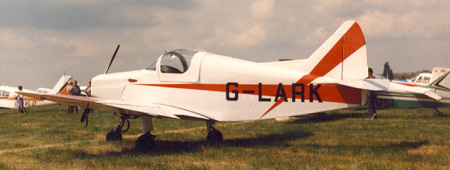 |
The Helton Lark is a reincarnation of the
1941 Culver Cadet, which was initially designed by Al Mooney as a
pilotless drone (USAAF designation was PQ-8). The Lark was built
from 1962 onwards. The single-seat Lark is powered by a 90hp
Continental C-90 and has a top speed of 140mph. It is 17 feet 8
inches long, with a wing span of 26 feet 11 inches. Gross weight is
1,475lb.
This one, the only one in Britain, visited
Cranfield in 1998 |
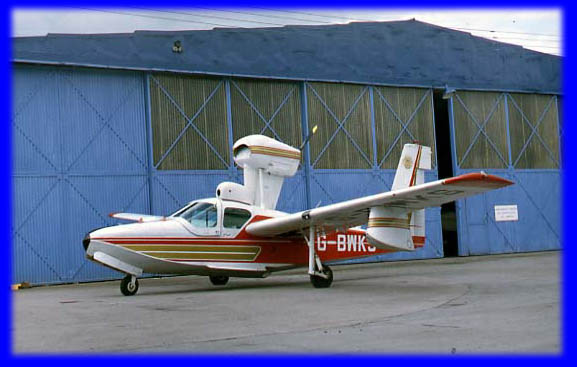 |
The Lake LA4 is one of a very small number of
amphibian aircraft. Lacking much competition (and being a pretty
good aeroplane) it is quite popular, having sold over 1,000. It
first flew as the Colonial Skimmer in July 1948; after the design
was taken over by Lake Aircraft, it flew in LA4 form in November
1959. Initially powered by a 180hp Lycoming engine, it was later
upgraded to 200hp (known as the Buccaneer) or 250hp (Renegade). Most
versions are four seaters; the Renegade seats six. The Buccaneer
grosses 2,700lb and cruises at 140mph; maximum range is 800 miles.
It is 24 feet 11 inches long, with a wing span of 38 feet. Most
notable feature is the strange engine mounting, designed to keep the
intake and propeller as far clear of spray as possible when
operating from water, at the expense of some dramatic trim changes
with power. This one was at Kidlington
in June 1980. |
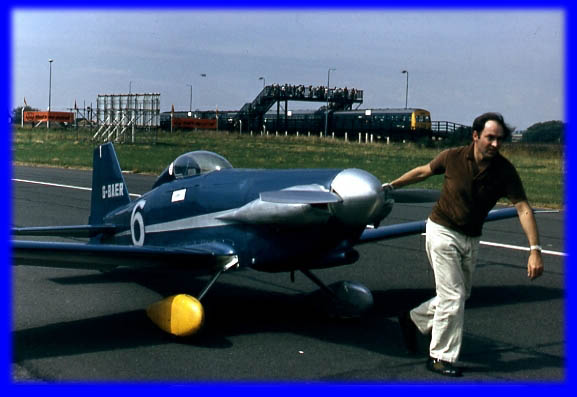 |
The LeVier Cosmic Wind was designed as a
specialist single seat racing aircraft by Tony LeVier, who at the
time was working for Lockheed. It is a diminutive aircraft, only
420lb gross weight, 16 feet long and with 19'6" wing span, powered
by an 85hp Continental engine. The type first flew in 1947. Three
were built initially, and a small number have also been completed as
homebuilts. One of the original four, `Ballerina', was entered with
some success in the 1964 World Aerobatic Championship; the superb
responsiveness of the controls more than compensated for the lack of
an inverted fuel system, rather a handicap in competition
aerobatics! Maximum diving speed is 300mph, astonishing for the
available power. This one was being
prepared for a race at Teesside, date uncertain. |
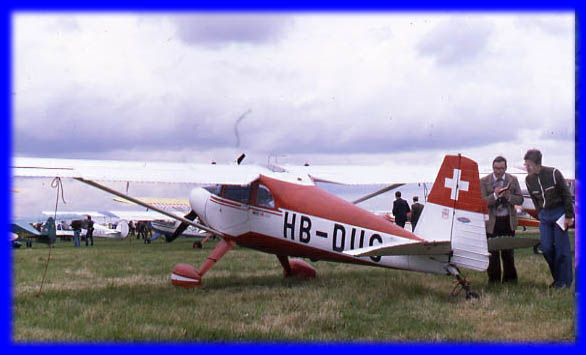 |
The Luscombe Silvaire is a stylish two seat
touring aircraft which was first introdued in 1937 - almost a decade
before the Cessna 120 and 140 with which it is visually easily
confused. Almost 6,000 were built in many different versions, with
various different engines from 50 to 90 horsepower. These gave a
gross weight ranging from 1,200 to 1,400lb and maximum cruising
speed between 100 and 110 mph. Typical range was 400 miles. It is 20
feet long, with a wing span of 35 feet. One of its best features is
fuel economy. During the second world war, many were impressed for
use by the US Army Air Force for light liaison duties, and were
known as the C-90.
This one was at Leicester in July 1980. |
|
|
The Maule M-4 Rocket first flew in September
1960. A tough, short take-off & landing machine, it was initially
powered by a 145hp Continental engine. Progressive upgrades
followed, leading ultimately to the MX-7, which has a mighty
235hp Lycoming engine. This higher powered aircraft has a gross
weight of 2,750lb and a top speed of 165mph, with a range of over
450 miles. A four seater, it is 22 feet long with a wing span of 29
feet 8 inches. Over 2,000 of all versions have been sold to date.
The top picture shows a Maule M-4 at Leicester in
July 1980. The lower picture is an MX-7 which visited Top Farm in
Autumn 2005. |
|
|
Al Mooney designed his distinctive M-20 in
the early 1950s; the first one flew in August 1953. Everything about
the M-20 is optimised for speed, from the very thin, smooth surfaced
wing to the extremely small frontal area for minimum drag. An
unfortunate side effect of this is that the cockpit is very cramped,
and the pilot's legs are stretched almost horizontally forward to
reach the rudder pedals. Still, the performance is worth it: on
145hp, the initial versions cruised at 160mph over a range of 850
miles. Over time, the type has been progressively upgraded and
renamed; examples include the M-20C Ranger, M-20E Chaparral, M-20F
Executive, M-20G Statesman, M-20J Mooney 201, M-20K Mooney 231,
M-20R Bravo, Encore and Ovation; and M-20S Eagle. All versions are
four seaters, but they differ in gross weight (from 2,575lb
initially to 3,370 for the Bravo), speed (the Bravo cruises at
240mph), range (the longest legged versions manage 1,150 miles), and
power (the highest being the Bravo's 270hp Lycoming engine).
Dimensions vary too, with length ranging from 23 feet 2 inches to 26
feet 9, and wing span from 35 feet to just over 36. All versions
have the characteristic forward swept tail. They are generally
regarded as up-market machines; over 7,500 have been built to date,
with several versions (including the Bravo) still being in
production. (Top -
M20J at Wellesbourne Mountford, January 2005. Centre - M20E at
Skegness, July 2005. Bottom - M20F Executive at Cranfield, date
uncertain.). |





|